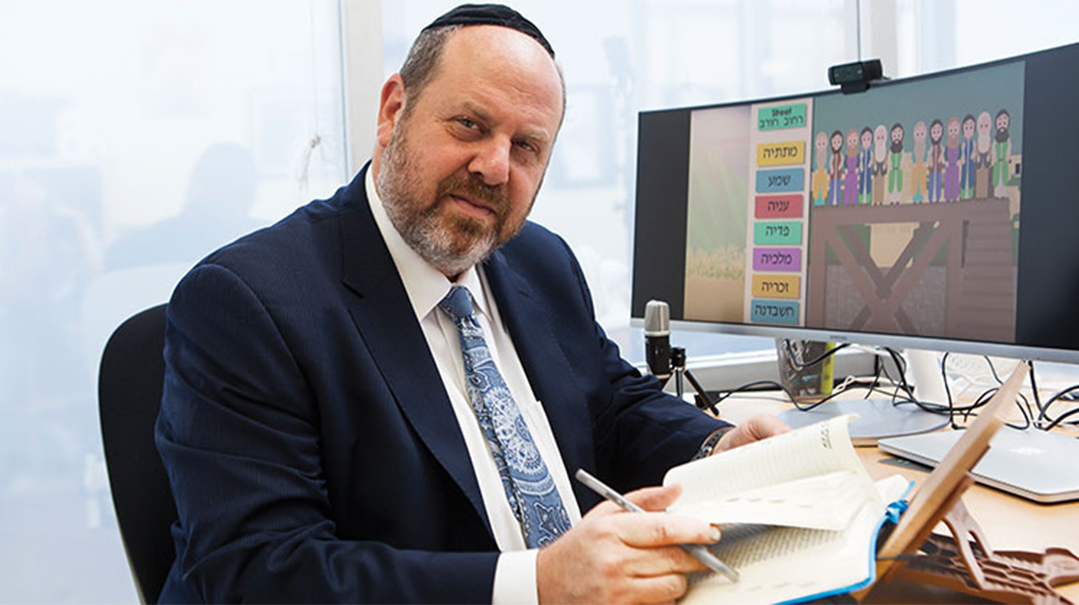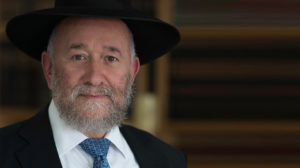Biblical Proportions


“The depth of the Torah is something you don’t have to ‘believe in.’ You can actually see it; you can experience it. When the layers of meaning begin to unfurl before your eyes — there is nothing more awe-inspiring than that.” (Photos: Amir Levy Aleph Beta Animation Team)
I t took one boring lesson to teach Rabbi David Fohrman that a class needs to capture the imagination and engage the listener and what better way than with animated videos? But could that breezy style be used to elucidate profound concepts in Torah uncover the deeply layered messages of Tanach? With thousands of subscribers and an international following the answer is obvious.
Early in his teaching career, Rabbi David Fohrman — creator of the popular Aleph Beta animated Torah videos — discovered the necessity of making his lessons interactive. As a nineteen-year-old bochur, he spent a summer in Australia teaching Jewish high school students. His carefully prepared lessons, however, elicited only blank stares and bored yawns. At one point, he presented a classic moral dilemma — a lifeboat at sea is being rocked by heavy waves and the only way to save most of the passengers is to cast one overboard. Is it permissible to do so? And if it is, who should be selected? After a short silence, one of the high schoolers replied: “I don’t know what I would do. But I do know one thing. You would certainly be the first person I’d toss overboard.”
He wasn’t a rabbi or a professional educator yet, but at that point, David realized that carefully outlined lesson plans are not enough to stimulate a yet-to-be inspired audience. Classes needed to fully engage and capture the imagination, and there needs to be a real back and forth. Years later, all of Rabbi Fohrman’s books and videos are written or scripted in a breezy style so that the reader or viewer — who might not even be Jewish — feels as if he is a participant in a back-and-forth conversation.
I first learned of the Aleph Beta project from a press release announcing that the American Forces Network (AFN), the broadcast service of the US military, had just concluded its very first agreement with a Jewish organization — that would be Rabbi Fohrman’s Aleph Beta, which has produced more than 600 animated Torah-based videos to date — to provide visual content for military servicemen and their families.
Most of Aleph Beta’s more than 6,000 monthly subscribers are Jewish, but about a quarter are gentiles, either Christians or self-described Noachides. Many years ago, when he started giving classes at Johns Hopkins University, Rabbi Fohrman asked his rosh yeshivah, Rav Yaakov Weinberg ztz”l, about the permissibility of teaching Torah to non-Jews. “You are teaching them from the Torah how a human being has to relate to G-d. That is certainly something they need to know,” Rav Weinberg paskened.
Although I was previously unfamiliar with Aleph Beta, Rabbi Fohrman and I learned together in the yeshivah of Rav Tzvi Kushelevsky in 1986, and I have read both his first two books, The Beast that Crouches at the Door (on parshas Bereishis) and The Queen You Thought You Knew (on Megillas Esther), multiple times.
I hadn’t seen him in about 15 years, when we met again around five years ago at the initiative of my friend Dr. Michael Bernstein from Lawrence. Bernstein told me he’d been challenged by his learning partner from Partners in Torah, a brilliant and highly successful hedge fund manager, to prove that the Torah is the product of a single Author.
He had arranged for his learning partner to meet a number of people, and asked if I wanted to join. The last stop on this cerebral tour was Rabbi Fohrman. He held us transfixed as he showed repeating ideational patterns in Sefer Bereishis. He demonstrated how many of the key events in the story of Creation are related as chiasms — or, as they are sometimes known, at-bash patterns. In this literary form, the first idea mirrors the last, the second idea mirrors the next to last, etc. After showing how this was true for the story of Creation, he then demonstrated how the same ideas and literary patterns are repeated in the story of the Flood (re-creation), and of Avraham Avinu (the creation of the Jewish People).
When he was done, I sat there stunned. The parallel chiasms from story to story are the Torah’s way of conveying great depth of meaning in a particularly concise form. But once revealed, they also form compelling proof of the Torah’s unitary authorship.
Perhaps what is most remarkable about Rabbi Fohrman’s presentations is the degree to which they are shaveh l’kol nefesh: They can simultaneously exhilarate talmidei chachamim, who are intimately familiar with the Torah texts, and excite those with little or no Torah background. Of late, I have been watching his weekly parshah videos on Erev Shabbos with several young grandchildren, who are thrilled by the animation and the references to the Biblical stories they are learning.
It’s All Connected
I sat down with Rabbi Fohrman during a recent trip of his to Eretz Yisrael to discuss the genesis of the Aleph Beta Academy, his aspirations for it, the nature of its appeal, and his unique methodology of Torah learning in general.
A clear subtext underlies all Rabbi Fohrman’s teaching: The Torah, G-d’s book, is the greatest possible proof of His existence. He relates a conversation he once had with a major Jewish philanthropist, who boasts of his atheism. “Why do you believe in G-d? Do you see any miracles nowadays that convince you of His existence?” the philanthropist challenged him.
He responded, “Well, there are many reasons to believe in G-d. But if you ask me which one speaks to me most and really convinces me that there is a G-d — the answer would be: His Torah.”
He elaborates further: “The depth of the Torah is something you don’t have to ‘believe in.’ You can actually see it; you can experience it. When the layers of meaning begin to unfurl before your eyes — there is nothing more awe-inspiring than that. No human author could write a text with such elegance, with such complex narrative patterns, in which different texts illuminate one another in so many ways simultaneously. The Torah is many orders of magnitude beyond any other text in its complex interrelatedness.”
Indeed Fohrman’s entire career is based on his ability to bring to others a palpable sense of awe in the study of Torah. In 1999, he began teaching a class he called “Genesis Unveiled” in the adult education division of Johns Hopkins University. Every week, two students lingered to continue asking questions as they walked Rabbi Fohrman to his car.
The questioners were LeRoy Hoffberger and his wife Rebecca, and they were both enthralled by their weekly learning with Rabbi Fohrman. One winter night, Hoffberger, a member of one of the wealthiest Jewish families in Baltimore, suddenly stopped in the middle of the back and forth, and asked Fohrman, who at that time was a writer for the Schottenstein Talmud Project (he spent seven years working for the Schottenstein Talmud), “Tell me, what’s your dream? What would you really like to do with your life?”
Fohrman replied that what he’d really like would be to devote himself to the kind of teaching he had begun to do at Johns Hopkins, though the possibility of being able to earn a living doing so had never occurred to him. Hoffberger told him, “I’d like to do what I can to help make that possible.”
Hoffberger then reached out to Rabbi Herman Neuberger, the legendary president of Ner Israel Rabbinical College, and together they developed the plan for the Hoffberger Foundation for Torah Studies, with Rabbi Fohrman as resident scholar. Not only did LeRoy Hoffberger, scion of a family affiliated with classical German Reform for generations, contribute half a million dollars of his own money to endow the Foundation, but he brought in an equal amount from the Hoffberger Family Philanthropies, as well as the Harry and Jeanette Weinberg Foundation of Baltimore.
How Come I Never Noticed?
There is no shortage of Torah scholars today, and never before has such a plethora of high-level Torah studies been so easily accessible. Today one can view many of the world’s most dynamic teachers of Torah without even leaving the house. So what’s the special attraction of Rabbi Fohrman’s approach to Torah learning?
The first key is legitimizing questions, instead of swatting them away. As a high school bochur in Ner Israel, David would call Rosh Yeshivah Rav Yaakov Weinberg from the pay phone in his dorm and ask whether he could come over to discuss his questions. Unbothered by the breach of protocol, and likely intrigued by David’s active mind, Rav Weinberg gave him an hour a week, off-and-on, over a period of years.
From Rav Weinberg, David understood the lesson that not only can one ask questions of the Torah text, one is obligated to do so. The classical commentators are not meant to be a substitute for thinking. “The mefarshim have all struggled with pshat, and they assume that you too have actually read closely the text upon which they are commenting,” Rav Weinberg taught.
Being encouraged to ask questions is perhaps even more important for those who have been familiar with the Torah texts since childhood. Too often they have been “anesthetized by their familiarity” — what Rabbi Fohrman calls the “Lullaby Effect.” And as a consequence, they miss “questions hiding in plain sight.”
The questions Rabbi Fohrman raises in his teaching have the quality of seeming obvious — elephants in the room — once he has broached them. “How could I have read this same story all these years and not seen this?” the reader or listener berates himself.
And his manner of posing the questions ensures that they will not go away. For instance, what sense does it make to name Purim after the lots Haman cast? Can we imagine naming a holiday after the device used by our enemy to try and destroy us? Would Israel commemorate Ben-Gurion’s declaration of Israel’s statehood by calling it ‘Tokarev Day’ after the Soviet rifles that constituted the Arabs most formidable weapons?
Even the really strong questions are not “problems” at all, Rabbi Fohrman emphasizes. “They are windows into a deeper level of meaning put there intentionally by Hashem. If we choose to close our eyes to those windows, we risk missing out on the important messages that might emerge from peeking inside.”
Rabbi Fohrman credits much of his evidence-based approach to the time he spent in Israel learning under Rav Tzvi Kushelevsky — with whom he clashed frequently. “First read the Rishonim carefully and know what they say before subjecting them to your philosophizing [one of the terms of greatest opprobrium in Rav Tzvi’s lexicon],” the Rosh Yeshivah would tell him. As resistant as Fohrman was to that advice when it was first given, it has permeated his thinking over time: Rav Tzvi’s method — based on close, nuanced readings — has become Rabbi Fohrman’s as well.
Like a Mystery
Rabbi Fohrman had been teaching mixed groups of secular and religious Jews for years before deciding to publish a work aimed equally at those who have been studying Chumash with the classical commentaries all their lives and those lacking even basic knowledge of Hebrew.
His first book, The Beast that Crouches at the Door, is a close reading of two of the best-known Biblical stories: Adam and Chavah’s eating from the Tree of Knowledge of Good and Evil, and Kayin’s murder of his brother Hevel. The book is philosophically deep, psychologically acute, hypersensitive to the nuances of the Biblical text, and reads like a mystery. Each short chapter ends with the reader hanging on the edge of the cliff eager to proceed.
By focusing on stories whose basic outlines are familiar, Rabbi Fohrman demonstrates how all of us — learned and unlearned alike — are prone to the “Lullaby Effect” when confronting well-known texts. No one ever thought to ask why a baby would be comforted by a song about a cradle crashing down from a treetop. And similarly, we fail to note obvious questions in the Biblical texts.
Nor does he shy away from the Big Questions: Why would a perfect G-d need to create the world? If Adam and Chavah had no knowledge of Good and Evil, why were they punished for eating from the fruit of the Tree? And if they did have such knowledge, what changed as a consequence of their eating?
He does not even fear arousing feminist wrath, noting the parallel between G-d’s curse of Chavah — “your desire will be to your husband, yet he will rule over you” — and His words to Kayin just before he murders Hevel — “its [the yetzer hara’s] desire is unto you, yet you can rule over it.” Does the Torah mean to analogize woman to the Evil Inclination?
To answer, Rabbi Fohrman turns to a midrash that links the two aforementioned teshukos to two others described in Tanach: that of rain for the land and that of Hashem for mankind. Clearly, the midrash is not equating Hashem to the yetzer hara: so neither is it equating Chavah to the yetzer hara. Rather, the midrash is suggesting that “teshukah” indicates a particular kind of desire — a desire that does not emanate from something lacking but from an overflow that seeks to join with and give to another. (To understand how that applies to the yetzer hara, read the book.)
Each chapter in The Beast that Crouches at the Door ends with what is known in yeshivos as a bombe kasha. I comment that the questions remind me of the old cowboy movie serials of the 1930s, where every week the hero was left dangling by his fingernails while hanging over the edge of the cliff. Rabbi Fohrman responds, “Exactly. I wanted to write in a style that the reader cannot put the book down or stop thinking about the questions. I want the reader to experience Torah as something that consumes you to the point that you become obsessed with answering the questions posed by the text.”
“Where have I heard that word or phrase before?” is one of Rabbi Fohrman’s most frequent starting points. He gives an example: “If a phrase strikes you as unusual, and you find that the only other place it appears in Chumash is 14 chapters earlier, your raise your eyebrow a bit. But if you find a whole slew of other such connections between the two texts as well — rare words or phrases — you eventually conclude that those connections are not coincidence. HaKadosh Baruch Hu is signaling to you that these two texts are interwoven, and each illuminates the other. Overlay the texts upon each other, as it were, and watch the three-dimensional meaning of each emerge.”
No doubt this method of Torah learning is unfamiliar to most yeshivah-trained bnei Torah. But the patterns, once discovered, cannot be ignored. Rabbi Fohrman suggests that what he calls “inter-textuality” is of very ancient derivation; indeed it is the method of the oldest commentary we have on Chumash: the Midrash. For instance, Chazal in Bereishis Rabbah found in Avraham’s descent to Egypt nearly a dozen elements that foreshadow his descendants’ exile in Egypt centuries later.
In the story of Tamar and Yehudah, which interrupts the narrative of the sale of Yosef by his brothers, Rashi notes (following the Midrash) that Tamar’s words upon sending Yehudah’s cloak back to him, “haker na — identify this” echo the brothers’ use of the exact same words one chapter earlier in presenting Yosef’s multicolored coat to Yaakov, and thereby alert the careful reader to a whole host of parallels between the situation of Yehudah and Yaakov. Such parallels are elucidated by Rabbi Fohrman in a 22-part series at Aleph Beta.
Who Else Says This?
One of those who was alternately bedazzled and unnerved by Reb David’s insights was his own stepfather, Zev Wolfson, the great Jewish philanthropist, with whom he learned almost nightly for 15 years. Wolfson would often challenge him: “Does anyone else say like you? Did you run this by an adam gadol?”
Eventually Wolfson arranged for him to meet in Jerusalem with the late Rav Moshe Shapira ztz”l at the latter’s house. Over nearly three hours, Rabbi Fohrman laid out his theories on the structure of the Ten Commandments and many other investigations he’d pieced together within the careful study of Chumash.
When Rabbi Fohrman finished, Rav Moshe told him he should return to America and create a school, for his approach has the potential to inculcate in students a deep sense of “emunas chachamim” by showing the precision and inner wisdom of the words of Chazal.
Aleph Beta Academy is in many respects the school for emunas chachamim that Rav Shapira envisioned. By 2013, Rabbi Fohrman had been teaching for over a decade under the auspices of the Hoffberger Institute for Torah Study, first in the Baltimore area and subsequently in the Five Towns. By then, he had acquired a legion of devoted followers and had created numerous series of Torah shiurim, released as audiotapes, and had published two books. But he was still looking for ways to help ever more Jews “fall in love with their Book.”
Around that time, Rabbi Fohrman encountered Khan Academy. A young hedge fund manager with three MIT degrees by the name of Salman Khan had put together a few videos explaining some math concepts. He had originally composed the videos to help his younger cousins with their math homework. But once those videos went viral, Khan began putting out videos on a wide range of subjects and in many languages, eventually spawning an entire educational company, whose instructional videos have been viewed over 1.5 billion times.
Rabbi Fohrman, whose work has received an effusive haskamah from Rav Dovid Cohen, wondered whether something similar might be done for Torah. After all, Khan’s initial videos were very simple and required no great technical expertise; their value came from their explanatory power. So Fohrman bought himself a $129 Wacom tablet and began to create some “Khan-style” videos of his own — explicating segments of Torah.
But the rabbi soon realized that if he were going to have the impact he sought, he would need a team — so he, together with tech entrepreneur Kuty Shalev, who was also a dedicated student, began to assemble one. Over time, they brought in production managers, editors, graphic artists, and marketing and customer service personnel.
The original target audience was educators and schools, which gave rise to the idea of animated video. The animations were designed to help illustrate the ideas and make them more accessible. And with his mellifluous, baritone voice, Rabbi Fohrman proved the ideal narrator.
While the core of the company is found in Aleph Beta Academy’s Hewlett, NY, office, many of the writers, editors, animators, and marketing staff work remotely from locations around the world. Team members communicate with one another regularly through video-conference. To date, the team has produced three full rounds of ten-minute “parshah-videos” — referred to affectionately in the office as “snacks.” Dozens of longer, multipart series — “meals” — have been produced on every holiday. And other series of much greater length — “feasts” — treat larger, grand themes in Chumash, such as the sale of Yosef by his brothers or the earlier narratives in the Torah such as Creation, Flood, and Migdal Bavel. And for the really intellectually fearless, currently in production is a series entitled “Difficult Stories in Tanach.”
Keeping the Romance Fresh
The work is extremely labor-intensive. Rabbi Fohrman estimates that each ten-minute video takes approximately 18 hours of his time to research, develop, and write. And even then, at least four editors review and comment on each script. The graphics editors display creative ingenuity of their own, often interjecting moments of wry visual humor, or finding striking ways to illuminate subtle ideas, truly allowing a “picture to tell a thousand words.” Aleph Beta’s annual budget is approximately $1.2 million, and it is funded through a combination of philanthropic gifts, and revenue — over half the total — from the thousands of subscribers who pitch in $9 a month.
The animation was an immediate hit with both students and teachers. Rebbetzin Sori Teitelbaum, who uses Rabbi Fohrman’s videos regularly in her yearlong Chumash class at HAFTR, says she found that her students quickly absorbed some of Rabbi Fohrman’s methodology and actually began asking deeper, more probing questions of the texts they were studying.
Rabbi Fohrman is thrilled that the Torah expounded upon in Aleph Beta is reaching far beyond the Orthodox community: Many subscribers are not-yet-observant Jews, and from its inception, Aleph Beta has produced educators’ guides and made its content freely available to Jewish educational institutions across the religious spectrum, and to home-schoolers. Aleph Beta has begun to expand beyond just the English-speaking world as well. To date, hundreds of videos have been translated into French and are being used widely in Jewish schools throughout France. Work has begun in Hebrew as well.
How does Rabbi Fohrman see his ultimate goal?: “To help Am Yisrael, the ‘People of the Book’ fall in love with their Book.” Rabbi Fohrman seeks to ensure that the romance remains fresh, alive, and vibrant — “that greater knowledge and greater inspiration go hand in hand.”
(Originally featured in Mishpacha, Issue 678)
Oops! We could not locate your form.












